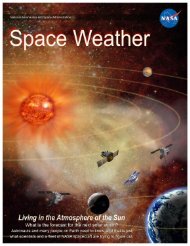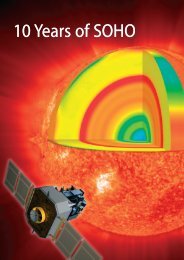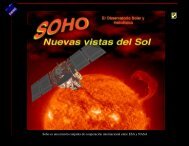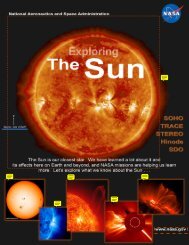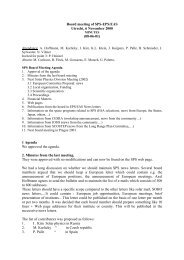Four years of SOHO Discoveries-Some Highlights - Nasa
Four years of SOHO Discoveries-Some Highlights - Nasa
Four years of SOHO Discoveries-Some Highlights - Nasa
- No tags were found...
Create successful ePaper yourself
Turn your PDF publications into a flip-book with our unique Google optimized e-Paper software.
ulletin 102 — may 2000 bullFigure 18. Massive ‘halo’CME as recorded byLASCO C2 on 17 February2000. Displayed here is aso-called ‘runningdifference’ image,showing the variation inbrightness from oneframe to the next(courtesy <strong>of</strong> <strong>SOHO</strong>/LASCOConsortium)Figure 19. Sequence <strong>of</strong>EIT difference imagesshowing the intensity(density) enhancementand following rarefactionassociated with a shockwave expanding acrossthe solar disc from thesite <strong>of</strong> the origin <strong>of</strong> aCME, recorded on 12 May1997. A halo CME wasobserved by LASCO.These images wereformed from thedifferences <strong>of</strong> successiveimages in the emissionlines <strong>of</strong> Fe XII near 195 Å;this ion is formed attemperatures <strong>of</strong> about 1.5million degrees. The wavefront travels at speeds <strong>of</strong>~ 300 km/s, typical <strong>of</strong> afast mode Alfvén shock inthe lower solar corona(from Thompson et al.)been missed during LASCO/EIT datagaps, bringing the possible associationrate to 18 out <strong>of</strong> 21 (86%).EIT has discovered large-scale transientwaves in the corona, also called‘Coronal Moreton Waves’ or ‘EITwaves’, propagating outward fromactive regions below CMEs. Theseevents are usually recorded in theFe XII 195 Å bandpass, during highcadence(< 20 min) observations. Theirappearance is stunning in that theyusually affect most <strong>of</strong> the visible solardisc (Fig. 19). They generally propagateat speeds <strong>of</strong> 200–500 km/s, traversinga solar diameter in less than an hour.Active regions distort the waves locally,bending them towards the lower Alfvénspeed regions. On the basis <strong>of</strong> speedand propagation characteristics, the EIT waveswere associated with fast-mode shock waves.Another interesting aspect <strong>of</strong> these coronalMoreton waves is their association with theacceleration and injection <strong>of</strong> high-energyelectrons and protons, as measured, forexample, by COSTEP and ERNE.Solar windOrigin and speed pr<strong>of</strong>ile <strong>of</strong> the fast windCoronal-hole outflow velocity maps obtainedwith the SUMER instrument in the Ne VIIIemission line at 770 Å show a clear relationshipbetween coronal-hole outflow velocity and thechromospheric network structure (Fig. 20), withthe largest outflow velocities occurring alongnetwork boundaries and at the intersection <strong>of</strong>network boundaries. This can be consideredthe first direct spectroscopic determination <strong>of</strong>the source regions <strong>of</strong> the fast solar wind incoronal holes.Proton and O VI outflow velocities in coronalholes have been measured by UVCS using theDoppler dimming method. The O VI outflowvelocity was found to be significantly higherthan the proton velocity, with a very steepincrease between 1.5 and 2.5 R , reachingoutflow velocities <strong>of</strong> 300 km/s at around 2 R (Fig. 21). While the hydrogen outflow velocitiesare still consistent with some conventionaltheoretical models for polar wind acceleration,the higher oxygen flow speeds cannot beexplained by these models. A possibleexplanation is <strong>of</strong>fered by the dissipation <strong>of</strong> highfrequencyAlfvén waves via gyroresonance withion-cyclotron Larmor motions, which can heatand accelerate ions differently depending ontheir charge and mass.Speed pr<strong>of</strong>ile <strong>of</strong> the slow solar windTime-lapse sequences <strong>of</strong> LASCO white-lightcoronagraph images give the impression <strong>of</strong> acontinuous outflow <strong>of</strong> material in the streamerbelt. Density enhancements, or ‘blobs’, formnear the cusps <strong>of</strong> helmet streamers and appearto be carried outward by the ambient solarwind. Sheeley et al., using data from theLASCO C2 and C3 coronagraphs, have traceda large number <strong>of</strong> such ‘blobs’ from 2 to over25 solar radii. Assuming that these ‘blobs’ arecarried away by the solar wind like leaves on82



